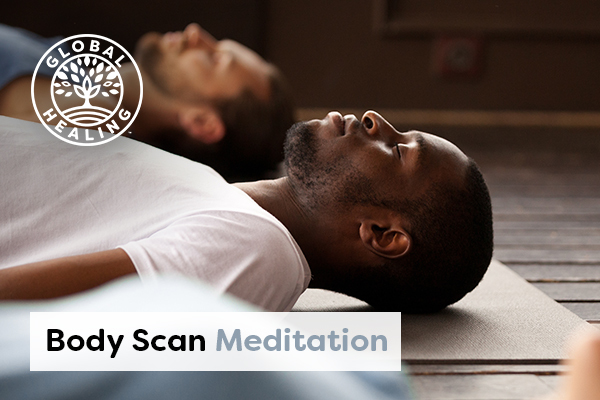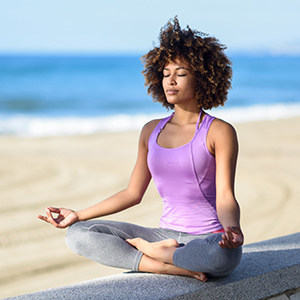
When you’re feeling stressed, it’s helpful to pay attention to your body because it helps ground you.[1, 2] There are many types of meditation to try, but body scan meditation is especially helpful when stress shows up in your body — a tight neck, headaches, or a clenched jaw. A body scan meditation involves mentally going through each part of your body and "checking in" to see how it is feeling. You may not even realize how tense you are until you do this exercise!
Connie H., a minister, therapist, and teacher in Menlo Park, California, uses meditation to focus on her bodily sensations during times of stress. "I like being outside to do body scan meditations. It’s much easier to unplug and let go of the events of the world and enjoy the pleasure of simply being, says Connie. "Sometimes, my husband joins me because he finds it healing. We sit in a comfortable spot, relax, and listen."
What Is Body Scan Meditation?
The purpose of a body scan meditation is to simply notice different parts of the body in order to relieve tension. It’s a type of mindfulness meditation, which is a mental exercise that helps you be more aware of your surroundings, body, and mind.[1, 2]
The definition of "body scan" gives away how it works: You "scan" your body sequentially by focusing on individual parts and paying attention to how they feel. Some people like to simply become aware of bodily sensations, while others prefer to relax each part of the body sequentially. In some versions of body scan meditation, you tighten muscles in different parts of the body and then relax them. Do what works for you!
The amount of time you spend on a body scan is also up to you. You can spend as little or as much as you want. If you prefer a longer one, the University of California-San Diego has several guided body scan meditations, ranging from 10 to 45 minutes in length.[3]
Some people like to breathe naturally during this exercise. Or you can use the meditation time to practice deep belly breathing. During deep breathing, take in slow breaths through the nose and feel your lower abdomen filling up with air, with little movement in the chest or shoulders. Breathe slowly out through the mouth. A good rule of thumb for deep breathing is 2 seconds in and 4 seconds out. Just remember, there’s no wrong or right way to do a body scan.
How Does Body Scan Meditation Reduce Stress?
Often, the goal of a body scan is to find the specific location of the tension you feel, so you can let go of it and relax.[2] Body scan meditations bring awareness back to your body so that you can gain greater insight into the connection between your body and mind.[2]
For instance, you may notice worrying about your job shows up as tension in your head or shoulders. Ultimately, this exercise helps you manage stress and regulate your emotions.[2] Lessening your anxiety and stress can bring about great joy and peace.
What to Do About Focus Issues
When you’re doing a body scan for the first time, it’s easy to lose focus. You may be distracted by different thoughts or feelings. Stay positive with yourself if your practice isn’t perfect. That’s why they call it a meditation practice!
Recognize that you’re having stray thoughts, let them pass, and refocus on your body. Gently guide yourself back to the body scan by thinking about how that particular body part feels.
Benefits of Long-Term Practice
"Thanks to doing body scan meditations for several years, I feel super connected to my body and have more energy. Overall, I’m in the best place emotionally and physically," says Jenelle H., founder and CEO of a publicist company in Beverly Hills, California.
Since body scan meditations can affect all of us differently, it’s hard to predict what long-term practice will do for you, but you’ll probably feel more relaxed and more in tune with your body. Stress has a negative impact on your health, so this or any type of meditation can have a tremendously positive impact on your mental wellness, reducing stress, calming the mind, and bringing balance to your life.
Step-by-Step Instructions for a 10-Minute Body Scan Meditation
You can use your mind to guide yourself through parts of the body without any external audio. You can also find guided body scan meditations online. We’ve created a step-by-step meditation that may help you locate the source of your body tension.
I recommend recording this on your phone or computer, and then playing the audio so you can follow along. Practice the body scan anytime you feel tension or just want to de-stress and relax. Soon enough, you will know it by heart!
- Sit or lie down in a comfortable place. You can do this anywhere, as long as it helps you relax. If you do lie down, try to stay alert, so you don't fall asleep. For that reason, most experts recommend avoiding meditating on your bed. Meditation works by keeping you at rest — but just above a sleeping state.
- It’s best that your feet touch the ground; this "grounds you" to the Earth. If you lie down on the floor, your whole body is in contact with the Earth. You do not have to be outside, because most floors are connected to the ground.
- Close your eyes. If you prefer, you can simply lower your eyes or have them in a gentle, half-closed state.
- Take a deep breath in and exhale. Repeat this two more times.
- Start the body scan at the top of your head (the crown). Focus your attention on this part of your body. Ask yourself: Do you have a headache? Does your head feel heavy? Try to release any tension you discover.
- Next, slowly move your focus down to your forehead. Is your forehead tense? Are you frowning? Is it relaxed? Try to create a pleasant, calm expression on your face.
- Move your focus down to your jaw. Are you clenching your jaw, or is it relaxed? Try to unclench your jaw.
- Now, move your focus down to your throat. Does your throat feel tight or dry? Does it feel constricted? Take a deep breath and try to relax your throat.
- Move your focus down to your shoulders. Do you feel tension between your shoulder blades? Are your shoulders raised up? Try to lower your shoulders and relax them.
- Move your focus down to your heart. Does your heart feel heavy or light? Imagine a weight being lifted from your heart. Take a few extra breaths here as you release any built-up emotion and flood your heart with love and peace.
- Next, move your focus down to your stomach. Do you have any stomach aches or pains? Do you have butterflies? Do you have a heavy feeling in your stomach? Do you feel constipated? Allow your abdomen to relax.
- Move your focus to your arms. Do they feel tired or heavy? Are your muscles tense? Do you have tightness in your shoulders? Relax your arms and shoulders.
- Move your mental focus to your legs. Do your legs feel tired or numb? Are your muscles tense? Imagine your legs releasing any muscular and physical tension.
- Move your focus down to your feet. How do your feet feel? Are they sore, tired, or achy? Wiggle your toes, move your feet around, and relax them.
- Now, reflect on which part of your body has the most tension. How does the tension feel? What do you think is causing it?
- Take a deep breath in and exhale.
- Take two more deep breaths.
- Imagine you’re holding a balloon in your hands. It can be any color or size you want. Now, imagine you can transfer all of the stress and tension in your body to this balloon. Fill the balloon with all of your negative thoughts and worries.
- Now, imagine gently letting go of this balloon as it floats away, and you can’t feel or see it anymore.
- When you’re ready, slowly open your eyes.
Congratulations! You have successfully completed a body scan meditation. This is such a fantastic, peaceful exercise that helps with stress reduction.
Other Ways to Reduce Stress
In a time of stress, self-care becomes a simple way to show yourself compassion. The body scan meditation is one of many ways to reduce stress. Another one of my favorite methods is to use herbs, such as holy basil (tulsi), to relax.[4] I drink holy basil in a hot tea and find that it has a calming effect on me, and I also like to eat stress-relieving foods.
Moving my body is another way I lower stress. Whether it’s through biking or walking, I find that going outside helps me relax. Exercise helps take my mind off the issues I’m facing, so the stream of negative thoughts stops. I’m able to live in the moment when I move my body, whether through intense exercise like running or gentle movement like yoga.
Points to Remember
A body scan meditation brings you mentally through all the different parts of your body, noticing where you have tension, and then releasing it. As you sequentially "scan" each body part, pay attention to where you’re holding the tension and how it feels. The body scan can help you relax and reduce stress.
Our 10-minute body scan meditation is easy to do at home and doesn’t require any type of special equipment. It’s great whether you’re a beginner at meditation or an old pro.
References (4)
- Sevinc G, et al. Common and dissociable neural activity after mindfulness-based stress reduction and relaxation response programs. Psychosom Med. 2018;80(5):439-451.
- Gibson J. Mindfulness, interoception, and the body: a contemporary perspective. Front Psychol. 2019;10:2012.
- Guided Audio & Video. Center for Mindfulness, University of California San Diego School of Medicine. Accessed 1 Apr 2020.
- Cohen MM. Tulsi - Ocimum sanctum: A herb for all reasons. J Ayurveda Integr Med. 2014 Oct-Dec;5(4):251-259.
†Results may vary. Information and statements made are for education purposes and are not intended to replace the advice of your doctor. If you have a severe medical condition or health concern, see your physician.










